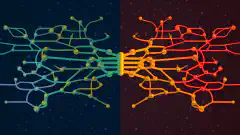Network Plus Course: Address Resolution Protocol (ARP) and Neighbor Discovery Protocol (NDP)

Table of Contents
Click Here to Return To the Network Plus Course Page
Introduction
In computer networks, the Address Resolution Protocol (ARP) and the Neighbor Discovery Protocol (NDP) play crucial roles in resolving IP addresses to MAC addresses and managing network communication. Understanding these protocols is essential for network administrators and individuals pursuing the CompTIA Network+ certification exam. This article provides a comprehensive overview of ARP and NDP, their functionalities, and common troubleshooting techniques.
How ARP Works: Understanding Address Resolution Protocol
The Address Resolution Protocol (ARP) plays a vital role in local network communication, enabling devices to determine the MAC address associated with a specific IP address. Let’s explore how ARP works and its significance in network connectivity.
Address Resolution Process
When a device needs to send data to another device on the local network, it first checks its ARP cache to find the MAC address corresponding to the destination IP address. If the MAC address is not present in the cache, the device initiates an ARP request.
The ARP request packet contains the IP address of the intended destination. This packet is broadcasted to all devices on the network, asking for the MAC address associated with the specified IP address.
When the device with the requested IP address receives the ARP request, it replies with an ARP reply packet. This reply packet contains the MAC address of the responding device. The original device then updates its ARP cache with the newly obtained MAC address.
ARP Cache
The ARP cache, also known as the ARP table, is a local database stored on a device. It maintains a record of IP-to-MAC address mappings discovered through ARP requests and replies. The ARP cache helps optimize network performance by reducing the need for frequent ARP requests.
However, entries in the ARP cache have a limited lifetime and can be invalidated if the corresponding device changes its MAC address or becomes unreachable. Regular ARP request and update processes ensure the cache remains up-to-date.
ARP Spoofing
ARP spoofing is a malicious technique used by attackers to manipulate ARP tables and intercept network traffic. In ARP spoofing, attackers send fake ARP replies with their own MAC address, tricking devices into associating their MAC address with a specific IP address.
By redirecting network traffic to their own devices, attackers can eavesdrop on or modify the communication. This can lead to various security threats, including data theft and unauthorized access.
To mitigate the risks associated with ARP spoofing, implementing security measures such as ARP inspection and MAC address filtering is crucial. These measures help detect and prevent unauthorized modifications to ARP tables, ensuring the integrity and security of network communication.
For more detailed information and examples, you can refer to the Address Resolution Protocol (ARP) documentation provided by the Internet Engineering Task Force (IETF).
Understanding how ARP works is essential for network administrators and engineers, enabling them to troubleshoot network connectivity issues and implement appropriate security measures.
Explaining NDP in IPv6 Networks
In IPv6 networks, the Neighbor Discovery Protocol (NDP) is used to perform functions similar to ARP in IPv4 networks. NDP provides address resolution, router discovery, neighbor unreachability detection, and duplicate address detection in IPv6 networks.
How ARP Works: Understanding the Functions of NDP
Network Discovery Protocol (NDP) is a crucial component of IPv6 networks, performing functions similar to the Address Resolution Protocol (ARP) in IPv4 networks. In this article, we will delve into the inner workings of NDP and its key functions, providing clear explanations and examples.
Address Resolution
The first function of NDP is Address Resolution, which involves resolving IPv6 addresses to their corresponding link-layer addresses (e.g., MAC addresses) on the local network. This process is essential for devices to communicate with each other within the network. Just like ARP in IPv4, NDP enables devices to find the MAC address associated with a specific IPv6 address.
Router Discovery
NDP facilitates the discovery of routers on the network, allowing devices to obtain the IPv6 addresses and routing capabilities of the routers. By discovering the routers, devices can effectively route IPv6 traffic and ensure proper connectivity. Routers play a crucial role in forwarding packets between networks, and NDP assists in identifying and communicating with them.
Neighbor Unreachability Detection (NUD)
Another critical function of NDP is Neighbor Unreachability Detection (NUD). NUD continuously monitors the reachability of neighboring devices on the network. If a device becomes unreachable or fails to respond, NDP can update the routing table and select an alternative path. This helps maintain a reliable network connection by dynamically adapting to changes in the network topology.
Duplicate Address Detection (DAD)
To prevent address conflicts, NDP employs Duplicate Address Detection (DAD). Before assigning an IPv6 address to a device, DAD verifies if the address is already in use on the network. The device sends a Neighbor Solicitation message to check for duplicate addresses. If a conflict is detected, the device will need to select a different IPv6 address to ensure uniqueness and avoid network disruptions.
These functions collectively contribute to the smooth operation of IPv6 networks, ensuring efficient communication and proper routing. Understanding how NDP works and its significance in network protocols is crucial for network administrators and engineers.
For more detailed information and examples, you can refer to the IPv6 Neighbor Discovery Protocol Specification provided by the Internet Engineering Task Force (IETF).
How ARP Works: Understanding NDP Messages and SLAAC
In order to understand how Address Resolution Protocol (ARP) works in IPv4 networks, it is important to explore the functions of the Neighbor Discovery Protocol (NDP) in IPv6 networks. NDP uses different message types to perform its functions, providing efficient network communication. Let’s delve into the details of NDP messages and their significance.
NDP Messages
NDP utilizes various message types to accomplish its functions:
Neighbor Solicitation (NS): When a device needs to find the link-layer address of a neighbor, it sends an NS message as a request. This message prompts the neighbor to provide its link-layer address.
Neighbor Advertisement (NA): In response to an NS message, a device sends an NA message, which contains its link-layer address. The NA message helps fulfill the address resolution process, allowing devices to communicate with each other.
Router Solicitation (RS): To discover routers on the network, a device sends an RS message. This message helps identify the presence of routers and enables further communication with them.
Router Advertisement (RA): Routers periodically send RA messages to announce their presence and provide network configuration information. These messages are crucial for devices to obtain necessary details about the network, such as network prefixes and other configuration parameters.
NDP and Stateless Address Autoconfiguration (SLAAC)
NDP plays a vital role in the Stateless Address Autoconfiguration (SLAAC) process in IPv6 networks. SLAAC allows devices to generate their own IPv6 addresses based on network prefix information obtained from Router Advertisement messages. By leveraging NDP’s Router Advertisement messages, devices can automatically configure their network interfaces with appropriate IPv6 addresses.
For more in-depth information on the Neighbor Discovery Protocol and its role in IPv6 networks, you can refer to the IPv6 Neighbor Discovery Protocol Specification provided by the Internet Engineering Task Force (IETF).
Understanding the mechanisms of NDP and its relationship with ARP in IPv4 networks is essential for network administrators and engineers, enabling them to ensure efficient and secure network communication.
Troubleshooting ARP and NDP Issues
When working with ARP and NDP, network administrators may encounter various issues that can impact network connectivity. Here are some common troubleshooting techniques for resolving these issues:
Clearing the ARP Cache: If there are incorrect or outdated entries in the ARP cache, clearing it can resolve connectivity problems. This can be done using the
arpcommand on Windows or thearp -dcommand on Linux .Verifying ARP Table Entries: Administrators should verify that the MAC address entries in the ARP table correspond to the correct IP addresses. Mismatched entries can be corrected manually using the
arpcommand.Detecting ARP Spoofing: To detect ARP spoofing, network administrators can use tools like Arpwatch or Wireshark to monitor ARP traffic and identify any inconsistencies or unexpected changes in MAC address mappings.
Resolving NDP Configuration Issues: In IPv6 networks, if devices are not obtaining the correct network configuration information from Router Advertisement messages, administrators should check the router’s NDP settings and ensure proper router advertisement interval and configuration parameters.
Analyzing Network Traffic: When troubleshooting ARP and NDP issues, analyzing network traffic using packet capture tools like Wireshark can provide valuable insights into the communication between devices. This can help identify any anomalies or errors in ARP or NDP messages.
Network Device Firmware Updates: Keeping network devices up to date with the latest firmware can help address known issues or vulnerabilities related to ARP and NDP. Check the manufacturer’s website for firmware updates and follow the recommended upgrade process.
Remember that troubleshooting network issues requires a systematic approach, including gathering information, isolating the problem, and applying appropriate solutions based on the analysis of the issue.
For more information on troubleshooting ARP and NDP issues, refer to the documentation and resources provided by the respective operating system or network equipment manufacturers.
Conclusion: Understanding ARP and NDP in Network Communication
In conclusion, the Address Resolution Protocol (ARP) and Neighbor Discovery Protocol (NDP) play crucial roles in network communication and address resolution. By understanding how ARP works, you can troubleshoot and optimize network connectivity.
ARP is responsible for resolving IP addresses to MAC addresses on local networks. It works by sending ARP request and reply packets to obtain the MAC address associated with a specific IP address. The ARP cache, or ARP table, stores these mappings to optimize network performance.
Similarly, NDP performs similar functions in IPv6 networks. It resolves IPv6 addresses to link-layer addresses and facilitates router discovery, neighbor unreachability detection, and duplicate address detection.
By implementing security measures such as ARP inspection and MAC address filtering, you can mitigate the risks associated with ARP spoofing, a malicious technique used to intercept network traffic.
Understanding these protocols is essential for network administrators and individuals preparing for network certification exams. By applying the knowledge gained from this article, you can effectively troubleshoot common network issues and ensure optimal performance and security.
For more detailed information and examples, you can refer to the Address Resolution Protocol (ARP) documentation provided by the Internet Engineering Task Force (IETF) and IPv6 Neighbor Discovery Protocol specification.
References
- Address Resolution Protocol (ARP)
- Neighbor Discovery for IP Version 6 (IPv6)
- IPv6 Stateless Address Autoconfiguration
- Arpwatch
- Wireshark
- CompTIA Network+ Certification Exam





